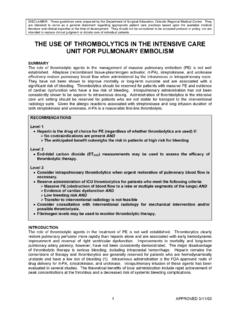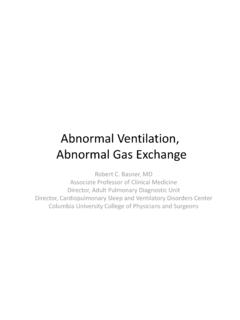Transcription of Preoperative Pulmonary Evaluation for Lung Resection
1 PCCP 17th MIDYEAR CONVENTION. State-of-the Art Pulmonology: Convergence of Practice August 7, 2014. Preoperative Pulmonary Evaluation for Lung Resection Outline of Discussion Objectives of Preoperative Pulmonary Evaluation of patients for surgical Resection Use of predicted postoperative Pulmonary function parameters to identify patients at increased risk for complications after lung Resection Prediction of postoperative Pulmonary function by technique of simple calculation and use of lung perfusion scan Algorithm for Preoperative Evaluation of patients for lung Resection Reduction of Pulmonary Function after Resection Across various
2 Studies, postoperative Pulmonary function values were assessed at various time intervals after lobectomy or pneumonectomy: FEV1: 84% - 91% of Preoperative values for lobectomy, 64% - 66% for pneumonectomy DLCO : 89% - 96% of Preoperative values after lobectomy 72% - 80% after pneumonectomy. VO2 max: 87% - 100% of Preoperative values after lobectomy 71% - 89% after pneumonectomy. P. Mazzone. Preoperative Evaluation of the lung Resection candidate. Cleveland Clinic Journal of Medicine May 2012; Vol 79, e-S17-22. Why do we do Preoperative Pulmonary Evaluation ?
3 Physiologic changes in the respiratory system occur in all patients undergoing surgical/anesthetic procedures. These changes may lead to complications, mortality and/or morbidity. Postoperative Complications (Within 30 days of surgery). Acute CO2 retention (PaCO2 > 45 mm Hg). Prolonged mechanical ventilation (> 48 h). Infections (bronchitis & pneumonia). Atelectasis (necessitating bronchoscopy). Bronchospasm Exacerbation of the underlying chronic lung disease Pulmonary embolism Symptomatic cardiac arrhythmias Myocardial infarction Death C. Wyser et al.
4 Prospective Evaluation of an Algorithm for the Functional Assessment of Lung Resection Candidates. Am J Respir Crit Care Med 1999;159:1450 1456. F. Grubisic-Cabo et al., Preoperative Pulmonary Evaluation for Pulmonary and Extrapulmonary Operations. Acta Clin Croat. Vol. 42 No. 3, 2003; 237-240. Preoperative Evaluation The purpose of Preoperative Evaluation is not to CLEAR patients for elective operations but rather to EVALUATE and, if necessary, to IMPLEMENT measures to prepare high risk patients for the operation. F. Cabo etal., Preoperative Pulmonary Evaliuation for Pulmonary and Extrapulmonary Operations.
5 Acta Clin Crotia 2003. F. Grubisic-Cabo et al., Preoperative Pulmonary Evaluation for Pulmonary and Extrapulmonary Operations. Acta Clin Croat. Vol. 42 No. 3, 2003; 237-240. Objectives of Preoperative Pulmonary Evaluation RISK ASSESSMENT to identify patients who are at increased risk of respiratory morbidity and mortality RISK REDUCTION to institute corrective and preventive measures to minimize the risk of respiratory morbidity and mortality Preoperative Evaluation for Lung Resection Surgery Who should be evaluated? The general answer . All patients undergoing lung Resection surgery, irrespective of age or extent of the lesion.
6 F. But unlike general surgery, Preoperative Evaluation of patients scheduled for lung Resection , requires spirometry testing and, if necessary, cardiopulmonary exercise testing (CPET). Current International Guidelines American College of Chest Physicians (ACCP) - 3rd Edition, 2013. British Thoracic Society (BTS) /. Society for Cardiothoracic Surgery in Great Britain and Ireland - 2010. European Respiratory Society (ERS) /. European Society of Thoracic Surgery (ESTS) - 2009. CASE. Z. B., 82-year-old male former 40 pack years smoker CXR = RUL mass FNAB = Squamous cell carcinoma Chest CT scan: - x x cm pleural based mass with punctate calcification & irregular, spiculated margins in the apical & posterior segments of RUL.
7 - No enlarged lymph nodes seen. - No pleural effusion seen. - Liver and both adrenal glands appear normal. Other Metastatic Work-ups: Negative Clinical Stage: T2bN0M0 (Stage IIA). Cardiac Evaluation : Low risk Management Plan: Lung resective surgery Case : Pulmonary Function Tests Spirometry Ref Pre Pre Post Post %. Meas % Ref Meas % Ref Chg FEV1/FVC 68 58 55. FEV1 (L) 67 68 0. FVC (L) 73 77 6. Diffusion Ref Pre Pre Meas % Ref DLCO 72. DL/VA VA Liters Role of Pulmonary Function Testing Aim: To determine the risk for respiratory complications and mortality based on the patient's Preoperative lung function and estimated section lung function.
8 FEV1 : predictive of postoperative complications, including death DLCO : predictive of postoperative complications, including death, length of hospital stay and hospital costs Question 1. What will be your next step in the Preoperative assessment? A. Clear patient for RU. lobectomy B. Calculate for the percent predicted FEV1 and DLCO. C. Order a lung perfusion scan D. Order CPET. Abbreviations percent predicted PPO FEV1% postoperative FEV1. percent predicted PPO DLCO% postoperative diffusing capacity for carbon monoxide percent predicted PPO VO2 max% postoperative maximal or peak oxygen consumption The PPO designation is added to indicate that the estimated parameter refers to the late postoperative period (3-6 months after the surgical procedure).
9 Degani-Costa, et al. Rev Bras Anestesiol. 2014. FEV1 and PPO FEV1. FEV1 and PPO FEV1 associated with increased respiratory morbidity & mortality rates FEV1 an independent predictor of respiratory morbidity ( OR, for every 10% decrease in FEV1 ). FEV1 < 30% 43% morbidity rate FEV1 > 60% 12 % morbidity rate Licker et al. (Ann Thorac Surg . 2006 ) confirmed that the best cutoff value of FEV1 for predicting respiratory complications was 60%. ACCP Evidence-Based CPG (3rd Edition) 2013. Preoperative FEV1. Data from > 2,000 patients in 3 large series in the 1970s : Mortality rate of < 5% if.
10 - Preoperative FEV1 > 2 L for a pneumonectomy - Preoperative FEV1 > L for a lobectomy FEV1 > 80% predicted accepted indicates that the patient should be considered suitable to undergo pneumonectomy without further Evaluation . ACCP CPG (2nd Edition) 2007. BTS CPG 2001. Preoperative FEV1. If there is no evidence of either undue dyspnea on exertion or interstitial lung disease and: FEV1 > 80% predicted or > 2 L suitable for Resection including pneumonectomy without further physiologic Evaluation . FEV1 is > L suitable for a lobectomy without further physiologic Evaluation .









